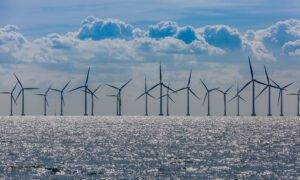World’s biggest offshore wind farm to be built in British waters

<?xml encoding=”utf-8″ ?????????>
The world’s biggest offshore wind farm is to be built in British waters after its developer said it planned to charge consumers higher prices for some of its electricity.
Orsted said it was pressing ahead with the £8 billion Hornsea Three development, which could power more than three million homes, after threatening to pull the plug on it this year because of soaring costs.
The Danish state-controlled energy group said it would ditch part of the contract it secured from the UK government last year to supply power from the project at a record low price to consumers. It now plans to seek a new contract at a higher price in respect of a quarter of the wind farm after the government confirmed that more generous contracts would be on offer next year.
Orsted said it had also worked with supply chain companies to renegotiate or tighten contracts to reduce risk from the project and had benefited from “helpful” tax breaks unveiled in the autumn statement.
Hornsea Three will comprise about 200 wind turbines about 75 miles off the coast of Norfolk, with a total capacity of up to 2.9 gigawatts, making it the world’s biggest single offshore wind farm. Orsted said it expected the project to start generating towards the the end of 2027 and that it could support up to 5,000 jobs during its construction. The site promises to make a significant contribution to the government’s goal of Britain having 50GW of offshore wind operational by 2030, up from about 14GW today.
Orsted is the world’s biggest offshore wind developer and it already operates the neighbouring Hornsea One and Hornsea Two wind farms, which successively have taken the title of being the world’s biggest.
Hornsea Three was one of five offshore wind projects that won contracts from the government via an auction last year, guaranteeing their revenues at a record low price to consumers of £37.35 per megawatt-hour in 2012 money.
The contract is indexed to inflation, but the industry says its costs have risen far more steeply amid supply chain chaos and soaring commodity costs since Russia’s invasion of Ukraine. In July another of the projects that secured a contract last year was scrapped by Vattenfall, its developer.
The government said last month that it would offer contracts at up to £73/MWh in 2012 money through next year’s auction. Orsted plans to use its contractual right to scrap the original contract in respect of a quarter of the wind farm’s capacity and to seek a new contract next year instead.
Duncan Clark, head of Orsted UK, said: “Despite an absolutely extraordinary sequence of events, the vast majority of that capacity is being delivered under that original record-breaking low-price contract. The rest of it will be delivered under a competitive price for the world we live in today.”
Orsted threatened in March to shelve Hornsea Three if tax breaks were not offered in the budget. Then it said it was disappointed with the three-year package of tax breaks that were unveiled. Permanent tax breaks were unveiled in the autumn statement that Clark described as “helpful”. However, he said the biggest factors enabling the project to proceed had been confidence in its ability to secure a higher-priced contract next year, after the government acknowledged that “the world has changed”, and progress in contract terms with its suppliers.
Clark said that “macroeconomic turbulence” had settled since earlier in the year. He described the go-ahead as a “vote of confidence in the UK market for offshore wind”.
Emma Pinchbeck, chief executive of Energy UK, the energy industry body, said: “This is very good news for the UK because Hornsea Three will not only deliver a major boost to our supply of clean domestic power but also will bring a host of benefits such as new jobs, opportunities for the supply chain and a lift to the local economy.”




